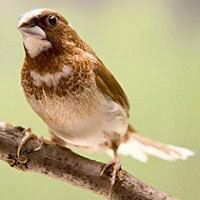Finch - Society
Bengalese Finch, Japanese Mövchen Finch, Japanese Movchen Finch Scientific Name: Lonchura domestica
Mon, 30th June, 2025 - 9:52 pm GMT
Sponsor Ads:

Alternative Name
Bengalese Finch, Japanese Mövchen Finch, Japanese Movchen Finch Scientific Name: Lonchura domesticaBasic Info
The Society Finch is accepted in a wide variety of types and colors. Please read the related article, "The Society Finch: So many possibilities!!" for more information on many of the different color and frilled varieties. Some claim to be able to distinguish males from females by the differences in the head and beak regions, but others maintain this is not a sure way and the best way is to examine behavior. The only way to know with 100% certainty prior to mating or pairing is to get a genetic test from your veterinarian. Because the Society Finch has been bred and kept world wide for centuries there are differences in the appearances of the European, American and Asian varieties. Much of the differences are due to breeders taking interest in different areas. The Japanese specialize in frilled varieties, while the European Varieties display larger size and scaled bellies.
Health
The Society Finch is one of the most prolific species of Finch. They have no specific breeding season and can be encouraged to mate at any time of year. Clutches, should not be had more than three times a year. In addition to reproducing well they make great parents and are often used to foster babies of other species. They should not be interbred with other species. Breeding The society finch is among the easiest birds to breed. Often they are used to foster other eggs of like size to their own. They are excellent egg sitters and excellent parents to the birds they care for. One can even encourage a cage of just two males to hatch and care for the eggs of other birds.Habitat
N/ABehavior
The Society Finch is one of the oldest and most loved finches kept by fanciers today. His cheerful personality and beautiful colors are only some of the reasons why so many love this wonderful breed. The Society Finch (also known as the Bengalese Finch or Japanese Movchen Finch) is well named, as he is a social and friendly bird. They take great love in living in groups and will often be seen huddling together for sleep and preening each other. They are also curious and playful birds making them wonderful pets. In addition he is neither too noisy nor overly active. The males of this species sing a lovely song, while the females are usually limited to chirping. In rare instances singing is seen in females but this is not the norm and should not be expected. Unlike other breeds of finch the Society Finch only exists in captivity. It has never existed in the wild; rather he is the product of careful breeding by man through the centuries. Because they have had such a long history with humans they are not as easily stressed as other Finch varieties, and for this reason make a better choice for novices.Origin
ChinaHistory
Originating in China the Society Finch is one of the oldest breeds of finch. Carlos Linneas first named them in 1766. The history of the Society Finch seems to be the subject of some debate. The fact that it is an entirely man-made finch created through generations of selective breeding is not a subject for debate. Nor are its relation to other manikins such as the various Asian and Indonesian munia species and the Spice Finch. But its relation to some other species is debated and not known with certainty. There also seems to be some debate over the scientific name of this finch. Some classify it as Lonchura striata and others classify it as Lonchura domestica.Common Foods
N/ASponsor Ads:
"When the general is weak and without authority; when his orders are not clear and distinct; when there are no fixes duties assigned to officers and men, and the ranks are formed in a slovenly haphazard manner, the result is utter disorganization." -- Sun Tzu, The Art of War
Finch - Society
Coded by: BGID® | ALL RIGHTS RESERVED Copyright © 2000-2025
Disclaimer | Privacy | Report Errors / Contact | Credits
















